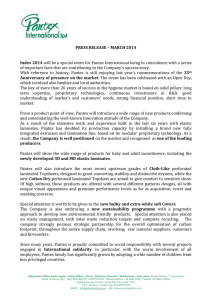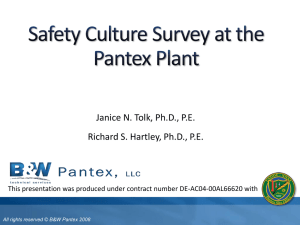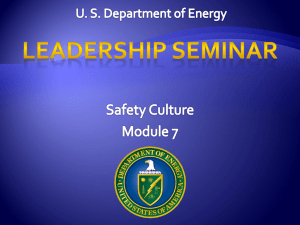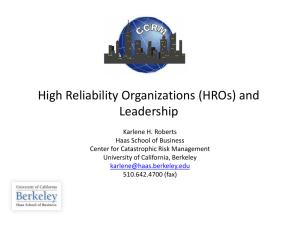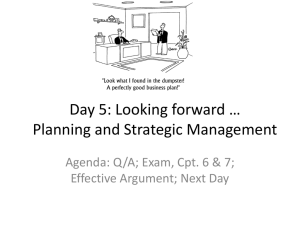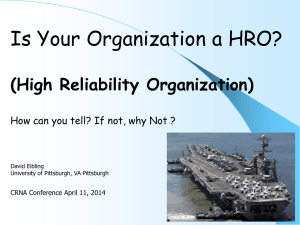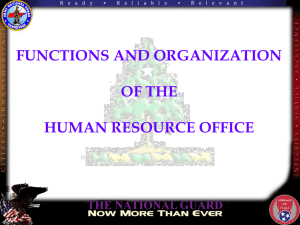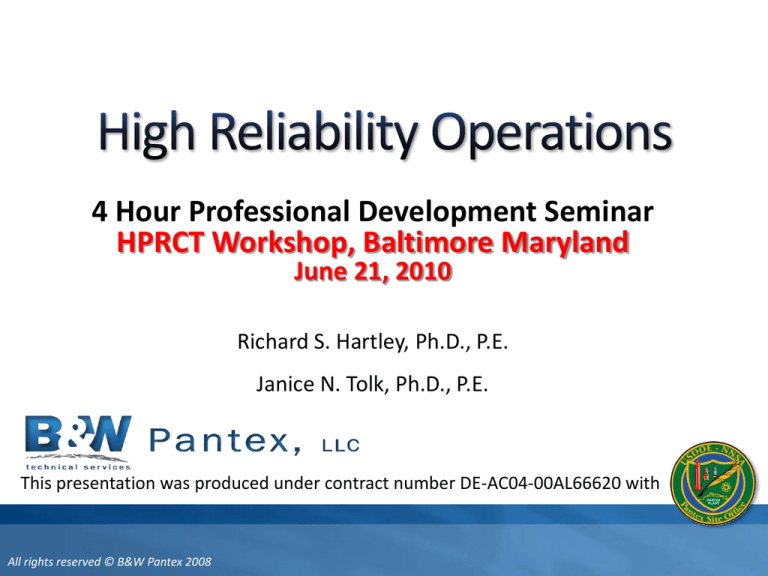
4 Hour Professional Development Seminar
HPRCT Workshop, Baltimore Maryland
June 21, 2010
Richard S. Hartley, Ph.D., P.E.
Janice N. Tolk, Ph.D., P.E.
This presentation was produced under contract number DE-AC04-00AL66620 with
All rights reserved © B&W Pantex 2008
An organization that repeatedly accomplishes
its mission while avoiding catastrophic events,
despite significant hazards, dynamic tasks, time
constraints, and complex technologies
A key attribute of being an HRO is to learn from
the organization’s mistakes
A.K.A. a learning organization
All rights reserved © B&W Pantex 2008
2
or Not?
Nuclear Navy
Commercial nuclear power
Aircraft carrier operations
Hospital patient care
Military nuclear deterrent
Forest service
Aviation
Nuclear weapons assembly and disassembly
All rights reserved © B&W Pantex 2008
3
Is it right for you?
All rights reserved © B&W Pantex 2008
4
DOE TRC and DART Case Rates
All DOE TRC Rate
All DOE DART Case Rate
Cases per 200,000 workhours
4.00
3.50
3.00
2.50
2.00
1.50
1.00
Contractor
ISM
deployed
0.50
0.00
1993
1994
1995
1996
1997
1998
1999
2000
2001
2002
2003
2004
2005
2006
2007
2008
YEAR
Data as of 7/7/2009
DOE injury rates have come down significantly since
Integrated Safety Management (ISM) was adopted
All rights reserved © B&W Pantex 2008
5
Cost (¢/kwh)
Rx Trips/
Scrams
Capacity Factor
(% up)
Significant
Events/Unit
Nuclear Energy Institute (NEI) Data
All rights reserved © B&W Pantex 2008
6
The Normal Accident Organization
All rights reserved © B&W Pantex 2008
8
As Columbia and Davis-Besse have
demonstrated, great safety stats don’t equal real,
tangible organizational safety.
The tendency for normal people when confronted
with a continuous series of positive “stats” is to
become comfortable with good news and not be
sensitive to the possibility of failure.
“Normal people” routinely experience failure by
believing their own press (or statistics).
All rights reserved © B&W Pantex 2008
9
When NASA lost 7
astronauts, the
organization's TRC rate
was 600% better than
the DOE complex.
And yet, on launch day
3,233 Criticality 1/1R*
hazards had been
waived.
* Criticality 1/1R component failures
result in loss of the orbiter and crew.
All rights reserved © B&W Pantex 2008
CAIB: “The unexpected
became the expected,
which became the
accepted.”
10
Had some performance “hard
spots” in the 80's
Had become a world-class
performer in the next 15 years
Preceding initiating events of mid
90's
Frequently benchmarked by
other organizations
While a serious corrosion event
was taking place
Complete core melt near miss in
2002
All rights reserved © B&W Pantex 2008
11
SYSTEM ACCIDENT TIMELINE
1979 - Three Mile Island
1984 – Bhopal India
1986 – NASA Challenger
1986 – Chernobyl
1989 – Exxon Valdez
1996 – Millstone
2001 – World Trade Center
2005 – BP Texas City
2007 – Air Force B-52
2008 – Stock Market Crash
What
is
Next?
Who is Next?
All rights reserved © B&W Pantex 2008
Attempts to Understand & Prevent System Accidents
All rights reserved © B&W Pantex 2008
13
Attempts to Understand & Prevent System Accidents
(High Reliability vs. Normal Accident Theory)
All rights reserved © B&W Pantex 2008
"Most ailing organizations have developed a
functional blindness to their own defects.
They are not suffering because they cannot
resolve their problems, but because they
cannot see their problems.“
John Gardner
All rights reserved © B&W Pantex 2008
15
Individual Accidents OR Systems Accidents?
All rights reserved © B&W Pantex 2008
16
An accident occurs wherein the worker is not
protected from the plant and is injured (e.g.
radiation exposure, trips, slips, falls, industrial
accident, etc.)
Plant
(hazard)
Human Errors
(receptor)
All rights reserved © B&W Pantex 2008
Focus:
Protect the
worker from
the plant
17
An accident wherein the system fails allowing a
threat (human errors) to release hazard and as a
result many people are adversely affected
Workers, Enterprise, Surrounding Community,
Country
Plant
(hazard)
Human Errors
(threat)
Focus:
Protect the
plant from
the worker
All rights reserved © B&W Pantex 2008
The emphasis on the system accident in no way degrades the
importance of individual safety , it is a pre-requisite of an HRO
18
System accident - an occurrence that is
unplanned and unforeseen that results in serious
consequences and causes total system disruption
(i.e. death, dose, dollars, delays etc.).
System event - any unplanned, unforeseen
occurrence that results in the failure of the
system that does not result in catastrophic
consequences -- indicates a breakdown in the
system vital to the well-being of many people
and the survivability of the organization!
All rights reserved © B&W Pantex 2008
19
Some types of system failures are so punishing
that they must be avoided at almost any cost.
These classes of events are seen as so harmful
that they disable the organization, radically
limiting its capacity to pursue its goal, and
could lead to its own destruction.
Laporte and Consolini, 1991
All rights reserved © B&W Pantex 2008
20
HROs vs. NAT Organizations
All rights reserved © B&W Pantex 2008
21
R=CxP
Risk = Consequence x Probability
If we are truly working with high-risk operations,
ethically and morally we should not be in business!
22
All rights reserved © B&W Pantex 2008
Belief of HRO
Accidents can be avoided by
organizational design and management
i.e. Risk = C x P is manageable
Dr. Karlene Roberts
Belief of NAT
Accidents are inevitable in
complex and tightly coupled operations
i.e. Risk = C x P is too high
All rights reserved © B&W Pantex 2008
Dr. Charles Perrow
23
Belief of HRO
Accidents can be avoided by
organizational design and management
i.e. Risk = C x P is manageable
Control of Risk
Belief
DOE reduces “C” by:
of NAT
minimizing the
hazard and/or
Accidents
are
mitigating the consequence
inevitable in
complex and tightly coupled operations
DOE reduces “P” - human performance improvement
i.e. Risk = C x P is too high
human performance error precursors
barriers
All rights reserved © B&W Pantex 2008
24
Linear interactions
Expected & familiar production or maintenance sequences
Visible, even if unplanned
Simple -- readily comprehensible
Complex interactions
One component can react with others outside normal production
sequence
Nonlinear
Unfamiliar sequences, or unplanned and unexpected sequences
not visible nor immediately comprehensible
All rights reserved © B&W Pantex 2008
25
Linear interactions
Expected & familiar production or maintenance sequences
Visible, even if unplanned
Simple -- readily comprehensible
Complex interactions
One component can react with others outside normal production
sequence
Nonlinear
Unfamiliar sequences, or unplanned and unexpected sequences
not visible nor immediately comprehensible
All rights reserved © B&W Pantex 2008
26
Linear Interactions
1
2
3
4
Complex Interactions
For complex interactions, 4
events lead to
12 possible interactions.
10
1
3
2
6
8
5
11
4
7
All rights reserved © B&W Pantex 2008
For linear
interactions 4
events lead to 4
interactions.
9
12
Greatly amplifies difficulty
in determining and
responding to the problem.
27
Complex interactions not necessarily high-risk
systems with catastrophic potential, examples:
Universities
R&D
Federal Government
Also takes another key ingredient
Tight coupling
28
All rights reserved © B&W Pantex 2008
Loosely coupled systems:
Ever done
this?
Delays possible; processes can remain in standby mode
Spur-of-the-moment redundancies and substitutions can be found
Fortuitous recovery aids possible
Failures can be patched more easily, temporary rig can be set up
Tightly coupled systems:
Time-dependent processes: they can’t wait or standby
Reactions in chemical plants – instantaneous, can’t be delayed or extended
Sequences invariant
Only one way to reach production goal
Little slack; quantities must be precise, resources can’t be substituted
Buffers and redundancies must be designed in, thought of in advance
All rights reserved © B&W Pantex 2008
29
Loose Coupling
All rights reserved © B&W Pantex 2008
Tight Coupling
30
More likely to have system accident
Power
Grids
DNA
Aircraft
Marine
transport
Rail
transport
Trade
Schools
Chem
Plant
Airways
1
2
3
4
Most Mfg.
Plants
Single goal agencies
Motor vehicle, post office
Your
Organization?
Nuclear
Weapon
Accidents
Space
Your
Organization?
Junior
College
Assembly line
production
Nuclear
Power
Military
Early warning
Military
Mining
R&D Firms
Multi goal agencies
DOE, OMB
Universities
Less likely to have system accident
(Can put in standby
mode)
Dams
(Increases escalation to
full-blown event)
HROs must neutralize
Linear < ----------------------Interactions ------------------------- > bad
Complex
effects here
Visible Interactions < --------------------Interactions --------------------- > Hidden Interactions
(Decreases the probability of
dangerous incident)
All rights reserved © B&W Pantex 2008
(Increases the probability of
dangerous incident)
Normal Accidents –Living with High-Risk Technologies, Perrow
31
According to Perrow:
Interactiveness increases the magnitude of
accident because of unrecognized connections
between systems
Tight coupling increases the probability of
initiating the accident
Together they are the makings
of a normal accident
All rights reserved © B&W Pantex 2008
32
Provide examples
In your own organization
In other organizations
In other places throughout the world
Where is today’s world going with regards
complexity and coupling?
Is this good or bad?
All rights reserved © B&W Pantex 2008
33
HRO
NAT
Accidents can be avoided by
organizational design and management
Accidents are inevitable in
tightly coupled and complex operations.
1
Better technologies
2
Better organizational processes
Dr. Charles Perrow
Perrow states that there are two primary
ways that organizations try to counter
interactive complexity (NAT)
34
All rights reserved © B&W Pantex 2008
HRO
Accidents can be avoided by
organizational design and management
HROs use the rational-closed system
construct to accomplish their goal by:
1. Maintaining safety as a leadership objective
2. Using redundant systems
3. Focusing on three operational and
management factors
decentralization,
culture, and
continuity
Dr. Scott Sagan
4. Being a learning organization
The Limits of Safety, Scott Sagan
All rights reserved © B&W Pantex 2008
35
HRO
Accidents can be avoided by
organizational design and management
Without leadership, safety
is but a facade.
HROs use the rational-closed system
construct to accomplish their goal by:
Multiple &
Independent Barriers
1. Maintaining safety as a leadership objective
Workers have to call the shots.
2. Using redundant systems
3. Focusing on three operational and
management factors
decentralization,
culture, and
continuity
Leaders want workers to call the shots
as they would.
Want workers to call the shots based
on experience – keep the plant open.
Learn from small mistakes –
information-rich events!
4. Being a learning organization
The Limits of Safety, Scott Sagan
All rights reserved © B&W Pantex 2008
36
NAT
Signs of Natural Actors
No clear consistent goals
Accidents are inevitable in
tightly coupled and complex operations.
Mgt at different levels have
conflicting goals
Unclear technology – organizations
don’t understand their own
processes
Signs of Open Organizations
Decision-makers come and go
Some pay attention, others don’t
Key meetings dominated by biased,
uninformed, uninterested personnel
NATs believe the natural-open organizational
system prevails because:
1. Conflicting leadership objective prevail
2. There are perils in redundant systems
3. There is no effective management
of
decentralization,
culture, or
continuity
4. Organizational learning is restricted
The Limits of Safety, Scott Sagan
All rights reserved © B&W Pantex 2008
37
Pressure to maintain production only
slightly modified by increased interests in
safety.
Redundant barriers, not independent.
Redundancy makes system opaque.
Redundancy falsely makes system
appear more safe.
NAT
Accidents are inevitable in
tightly coupled and complex operations.
NATs believe the natural-open organizational
system prevails because:
1. Conflicting leadership objective prevail
2. There are perils in redundant systems
Not enough time to improvise – tightly
coupled.
Leaders don’t know enough about their
operations to evaluate whether workers
are responding correctly or not.
Causes of accidents and near-misses
unclear –hard to learn.
Incentives to fabricate positive records
abound.
3. There is no effective management
of
decentralization,
culture, or
continuity
4. Organizational learning is restricted
The Limits of Safety, Scott Sagan
All rights reserved © B&W Pantex 2008
38
HRO
NAT
Accidents can be avoided by
organizational design and management
Accidents are inevitable in
tightly coupled and complex operations.
HROs use the rational-closed system
construct to accomplish their goal by:
NATs believe the natural-open organizational
system prevails because:
1. Maintaining safety as a leadership objective
1. Conflicting leadership objective prevail
2. Using redundant systems
2. There are perils in redundant systems
3. Focusing on three operational and
management factors
3. There is no effective management
of
decentralization,
culture, and
continuity
4. Being a learning organization
4. Organizational learning is restricted
Good
Bad
The Limits of Safety, Scott Sagan
All rights reserved © B&W Pantex 2008
decentralization,
culture, or
continuity
39
HRO
NAT
Accidents can be avoided by
organizational design and management
Accidents are inevitable in
tightly coupled and complex operations.
HROs use the rational-closed system
construct to accomplish their goal by:
NATs believe the natural-open organizational
system prevails because:
These are attributes of
HROs and NATs.
1. Maintaining safety as a leadership objective
1. Conflicting leadership objective prevail
2. Using redundant systems
2. There are perils in redundant systems
3. Focusing on three operational and
management factors
3. There is no effective management
of
The literature is silent on how
they are achieved or avoided.
decentralization,
culture, and
continuity
4. Being a learning organization
4. Organizational learning is restricted
Good
Bad
The Limits of Safety, Scott Sagan
All rights reserved © B&W Pantex 2008
decentralization,
culture, or
continuity
40
NAT theorists take their case to the extreme but don’t
dismiss their warnings
“Normal” implies it is likely to happen with “normal” organizations
It is “normal” to be human
We all relax if things go right
We all know we cut corners when we get busy
We all do what we have done before
We do what we see others do
The lack of negative response reinforces our belief that perhaps the rules
were too strenuous so we start cutting more corners more often
Those dealing with high consequence operations never
have the luxury of being “normal”
All rights reserved © B&W Pantex 2008
41
Reality Engineering
Understanding Socio-Technical Systems to
Improve Bottom-Line
All rights reserved © B&W Pantex 2008
42
a New
Initiative
TheNot
most
important
thing,
Way to Think
is Logical,
to keep Defensible
the most important
thing,
Based
onimportant
Logic & Science
the
most
thing.
Logic & Science
are
Time
and
New
th
Steven Covey, 8 Habit
Initiative Invariant
Focus on what is important
Measure what is important
All rights reserved © B&W Pantex 2008
43
Take a physics-based system approach
Measure gaps relative to physics-based system
Explicitly account for people
People are not the problem, they are the solution
People are not robots, pounding won’t improve
performance
People provide safety, quality, security, science etc.
Sustain behavior – account for culture
Improve long-term safety, security, quality
All rights reserved © B&W Pantex 2008
44
Spectrum of Safety
Hard Core Safety Physics
• Physics invariant
• Prevent flow of unwanted energy
• Delta function
As Engineers Write
All rights reserved © B&W Pantex 2008
Squishy People Part of Safety
• Average IQ of the organization
• It is a systems approach
• Gaussian curve
As People Do
Spectrum of Safety
Hard Core Safety Physics
• Physics invariant
• Prevent flow of unwanted energy
• Delta function
Old Mind-Set
Compliance-based safety
Squishy People Part of Safety
• Average IQ of the organization
• It is a systems approach
• Gaussian curve
High Reliability Organization
Explicitly consider human error
Take into account org. culture
Maximize delivery of procedures
Improve system safety
All rights reserved © B&W Pantex 2008
A Systems Approach to Safety
All rights reserved © B&W Pantex 2008
47
Human Errors
(threat)
Plant
(hazard)
If a systems approach is required to ensure we don’t have to
rely on every individual having a perfect day every day to
avoid the catastrophic accident,
then we had better take the best approach to implementing
that system!
All rights reserved © B&W Pantex 2008
48
We used Deming’s
Deming’s Theory
Theory of Profound
of Profound
Knowledge to
Knowledge (TPK)
develop a process
provides a
to attain those HRO
foundation for
attributes identified
the systems
by the High
approach
Reliability Theorists
W. Edwards Deming
All rights reserved © B&W Pantex 2008
49
Deming’s
Theory of
Profound
Knowledge
(TPK) used to
provide
foundation
for the
systems
approach
• Organizations are
systems that
interact within
their internal and
external
environments
• Theory,
prediction, and
feedback as the
basis of learning
All rights reserved © B&W Pantex 2008
• Statistical process
control is the
foundation of
process
optimization
Knowledge
of Systems
Knowledge
of
Variation
Knowledge
of
Knowledge
Knowledge
of
Psychology
• Organizations
have cultures that
influence the
system and
desired outcome
50
• Knowledge
of
Systems
• Knowledge
of
Variation
HRO Practice
#1
HRO Practice
Knowledge
#2
the Parts
of
Reduce
Variability
Variationin
HRO System
HRO Practice
Knowledge
#4
HRO Practice
Knowledge
#3
Learn of
& Adapt
as
an
Knowledge
Organization
Fosterof
a Strong
Culture
of
Psychology
Reliability
Knowledge
Manage the
of
Systems
System, Not
• Knowledge
of
Knowledge
All rights reserved © B&W Pantex 2008
• Knowledge
of
Psychology
51
• Knowledge
of
Systems
• Knowledge
of
Knowledge
All rights reserved © B&W Pantex 2008
• Knowledge
of
Variation
HRO Practice
#1
HRO Practice
#2
Manage the
System, Not
the Parts
Reduce
Variability in
HRO System
HRO Practice
#4
HRO Practice
#3
Learn & Adapt
as an
Organization
Foster a Strong
Culture of
Reliability
• Knowledge
of
Psychology
52
• Ensure system
provides safety
• Manage system,
evaluate variability
• Foster culture of
reliability
• Model
organizational
learning
• Generate decisionmaking info
• Tiered approach
• Refine HRO system
All rights reserved © B&W Pantex 2008
•Deploy system
•Evaluate operations
– meas. variability
•Adjust processes
HRO Practice
#1
HRO Practice
#2
Manage the
System, Not
the Parts
Reduce
Variability in
HRO System
HRO Practice
#4
HRO Practice
#3
Learn & Adapt
as an
Organization
Foster a Strong
Culture of
Reliability
•Provide capability
to make
conservative
decisions
•Make judgments
based on reality
•Openly question &
verify system
53
• Ensure system
provides safety
• Manage system,
evaluate variability
• Foster culture of
reliability
• Model
organizational
learning
• Generate decisionmaking info
• Tiered approach
• Refine HRO system
All rights reserved © B&W Pantex 2008
HRO Practice
#1
HRO Practice
#2
Manage the
System, Not
the Parts
Reduce
Variability in
HRO System
HRO Practice
#4
HRO Practice
#3
Learn & Adapt
as an
Organization
Foster a Strong
Culture of
Reliability
• Deploy system
• Evaluate
operations –
meas. variability
• Adjust processes
•Provide capability
to make
conservative
decisions
•Make judgments
based on reality
•Openly question &
verify system
54
• Ensure system
provides safety
• Manage system,
evaluate variability
• Foster culture of
reliability
• Model
organizational
learning
• Generate decisionmaking info
• Tiered approach
• Refine HRO system
All rights reserved © B&W Pantex 2008
HRO Practice
#1
HRO Practice
#2
Manage the
System, Not
the Parts
Reduce
Variability in
HRO System
HRO Practice
#4
HRO Practice
#3
Learn & Adapt
as an
Organization
Foster a Strong
Culture of
Reliability
• Deploy system
• Evaluate
operations –
meas. variability
• Adjust processes
•Provide capability
to make
conservative
decisions
•Make judgments
based on reality
•Openly question &
verify system
55
• Ensure system
provides safety
• Manage system,
evaluate variability
• Foster culture of
reliability
• Model
organizational
learning
• Generate decisionmaking info
• Tiered approach
• Refine HRO system
All rights reserved © B&W Pantex 2008
HRO Practice
#1
HRO Practice
#2
Manage the
System, Not
the Parts
Reduce
Variability in
HRO System
HRO Practice
#4
HRO Practice
#3
Learn & Adapt
as an
Organization
Foster a Strong
Culture of
Reliability
• Deploy system
• Evaluate
operations –
meas. variability
• Adjust processes
•Provide capability
to make
conservative
decisions
•Make judgments
based on reality
•Openly question &
verify system
56
• Ensure system
provides safety
• Manage system,
evaluate variability
• Foster culture of
reliability
• Model
organizational
learning
• Generate decisionmaking info
• Tiered approach
• Refine HRO system
All rights reserved © B&W Pantex 2008
HRO Practice
#1
HRO Practice
#2
Manage the
System, Not
the Parts
Reduce
Variability in
HRO System
HRO Practice
#4
HRO Practice
#3
Learn & Adapt
as an
Organization
Foster a Strong
Culture of
Reliability
• Deploy system
• Evaluate
operations –
meas. variability
• Adjust processes
•Provide capability
to make
conservative
decisions
•Make judgments
based on reality
•Openly question &
verify system
57
• Ensure system
provides safety
• Manage system,
evaluate variability
• Foster culture of
reliability
• Model
organizational
learning
• Generate decisionmaking info
• Tiered approach
• Refine HRO system
All rights reserved © B&W Pantex 2008
• Knowledge
of Variation
HRO Practice
#1
HRO Practice
#2
Manage the
System, Not
the Parts
Reduce
Variability in
HRO System
HRO Practice
#4
HRO Practice
#3
Learn & Adapt
as an
Organization
Foster a Strong
Culture of
Reliability
58
• Ensure system
provides safety
• Manage system,
evaluate variability
• Foster culture of
reliability
• Model
organizational
learning
• Generate decisionmaking info
• Tiered approach
• Refine HRO system
All rights reserved © B&W Pantex 2008
HRO Practice
#1
HRO Practice
#2
Manage the
System, Not
the Parts
Reduce
Variability in
HRO System
HRO Practice
#4
HRO Practice
#3
Learn & Adapt
as an
Organization
Foster a Strong
Culture of
Reliability
• Deploy system
• Evaluate
operations –
meas. variability
• Adjust processes
59
All rights reserved © B&W Pantex 2008
60
“Break the Chain” at Any Point & Stop the System Accident
Human
Performance
Error
Precursors
All rights reserved © B&W Pantex 2008
Evaluating the HRO
All rights reserved © B&W Pantex 2008
62
• Generate decisionmaking info
• Tiered approach
• Refine HRO system
All rights reserved © B&W Pantex 2008
HRO Practice
#1
HRO Practice
#2
Manage the
System, Not
the Parts
Reduce
Variability in
HRO System
HRO Practice
#4
HRO Practice
#3
Learn & Adapt
as an
Organization
Foster a Strong
Culture of
Reliability
•Provide capability
to make
conservative
decisions
•Make judgments
based on reality
•Openly question &
verify system
63
Spectrum of Safety
Hard Core Safety Physics
• Physics invariant
• Prevent flow of unwanted energy
• Delta function
Squishy People Part of Safety
• Average IQ of the plant
• It is a systems approach
• Gaussian curve
High Reliability Organization
Explicitly consider human error
Take into account org. culture
Maximize delivery of procedures
Improve system safety
All rights reserved © B&W Pantex 2008
or
2.
65
All rights reserved © B&W Pantex 2008
66
All rights reserved © B&W Pantex 2008
values
behaviors
67
All rights reserved © B&W Pantex 2008
modeled
by its leaders
68
All rights reserved © B&W Pantex 2008
internalized by its members
69
All rights reserved © B&W Pantex 2008
Dr. Edgar Schein
Most of the content of this section is adapted from Schein,
Organizational Culture and Leadership, 2004
All rights reserved © B&W Pantex 2008
70
(new organization, e.g. new start-up company)
Culture begins when leadership imposes its
values and assumptions on a group
If the group is successful because they use the
leader’s values and assumptions
likely these assumptions will be taken for granted
and as a result
you then have a culture defined for later
generations
What if the external environment changes?
Schein, Organizational Culture and Leadership, 2004
All rights reserved © B&W Pantex 2008
71
(existing organization, e.g. organization needing change)
Environment changes
Group runs into adaptive difficulties
Some assumptions are no longer valid
Leadership needs to step up once again
Leadership needs to step outside culture the leader
created and start evolutionary change to adapt to new
environment.
Ability to perceive limitations of one’s own culture and to
evolve culture adaptively is the essence and ultimate
challenge of leadership!
Schein, Organizational Culture and Leadership, 2004
All rights reserved © B&W Pantex 2008
72
Culture refers to:
Customs and rituals
Practices organization develops around their handling of
people
Espoused values and credo of an organization
Culture (good, bad, functionally effective) depends:
not only on the culture alone (internal integration), but
on the relationship of the culture to environment in which it
exists (external adaptation and survival)
Schein, Organizational Culture and Leadership, 2004
All rights reserved © B&W Pantex 2008
73
Culture points us to phenomena below surface
Powerful in their impact but
Invisible and, to a considerable degree, unconscious
Culture is to a group what personality is to an individual
Just as our personality and character guide and
constrain our behavior,
so does culture guide and constrain behavior of members of
a group through the shared norms that are held in that group
Schein, Organizational Culture and Leadership, 2004
All rights reserved © B&W Pantex 2008
74
The organization’s culture is its comfort zone while
adapting to survive its external environment
Personal examples of difficulties getting out of comfort
zones:
Diets
Exercise
Other examples?
Changes in culture require us to:
resurrect, reexamine, and possibly change
some of the more stable portions of our cognitive structure
Adapted from Schein, Organizational Culture and Leadership, 2004
All rights reserved © B&W Pantex 2008
75
Artifacts and
Behaviors
Easy to Observe – Difficult to Decipher
Includes what one sees, hears, feels when one encounters a new group
Includes visible products, architecture, language, technology, clothing
Climate – organizational processes, charters, org charts, etc.
What “ought to be” versus what “is”
Leader poses a solution to a problem not yet a shared basis
Group takes joint action and observes outcome
If outcome successful perceived value is transformed to shared values or beliefs
Espoused value = what “ought to be” vice what “is”
Espoused
Beliefs and
Values
Below the surface
Underlying
Assumptions
Basic assumptions: non-confrontable; non-debatable; hard to change
Changes intrinsically difficult -- release large quantities of anxiety
Rather than tolerate anxiety, we tend to distort, deny, or falsify what is going on
Must decipher underlying assumptions if hope to interpret and act on artifacts
Schein, Organizational Culture and Leadership, 2004
All rights reserved © B&W Pantex 2008
76
What You Do
What You Say
You’re Going
To Do
Artifacts and Behaviors
Espoused Values and Beliefs
What You
Really Feel
You Should
Do
Underlying Assumptions
Schein, Organizational Culture and Leadership, 2004
All rights reserved © B&W Pantex 2008
77
Artifacts and
Behaviors
The next level of safety
improvement will be
the most challenging
Its what I do,
not what I say.
Becoming
an HRO
Espoused
Beliefs and
Values
Desire to be
an HRO
Underlying
Assumptions
Balance and alignment between
espoused values and artifacts or
behaviors indicates employees
buying-into safety culture
Balance and alignment between
underlying assumptions and
espoused values indicates
leaders walking-the-talk
Adapted from Schein, Organizational Culture and Leadership, 2004
All rights reserved © B&W Pantex 2008
78
Artifacts and
Behaviors
Determine by
observing work
Determine by
interviewing leadership
Espoused
Beliefs and
Values
Misalignment hints at
deeper underlying
assumptions keeping the
organization from
attaining its desired
balance between
production and safety
Below the surface
Underlying assumptions must be
understood to properly interpret
artifacts and to create change
Underlying
Assumptions
Schein, Organizational Culture and Leadership, 2004
All rights reserved © B&W Pantex 2008
79
This cultural alignment is influenced by the way the organization:
Artifacts and
Behaviors
Adapts and
survives to its
external
environment
Becoming
an HRO
Espoused
Beliefs and
Values
Integrates
internally to
adapt as an
organization
Desire to be
an HRO
Underlying
Assumptions
80
All rights reserved © B&W Pantex 2008
Mission &
Strategy
Goals
Means
Remember culture concepts:
Leader imposes values and assumptions
(what he/she thinks will work)
Organization struggles to use the leader’s
values to adapt to its external environment
If the organization is successful, leaders
values are accepted as their values and the
culture has changed
Measurement
Correction
Schein, Organizational Culture and Leadership, 2004
All rights reserved © B&W Pantex 2008
81
Mission &
Strategy
Goals
Means
Measurement
Correction
Leader establishes a shared understanding of core mission,
primary task, and manifest and latent functions
Leader may provide strategies tie the mission to the goals
Leader develops consensus on goals, as derived from the core
mission
Leader develops consensus on means used to attain goals,
such as organization structure, division of labor, reward
system, and authority system
Leader develops consensus on criteria used to measure
how well group fulfils its goals
Leader develops consensus on the appropriate remedial or
repair strategies to be used if goals are not being met
Schein, Organizational Culture and Leadership, 2004
All rights reserved © B&W Pantex 2008
82
Mission &
Strategy
Goals
Means
Measurement
Correction
Leader establishes a shared understanding of core mission,
primary task, and manifest and latent functions
Leader may provide strategies tie the mission to the goals
Leader develops consensus on goals, as derived from the core
This
is
just
management
101
but
mission
perhaps now you have a better
Leader develops consensus on means used to attain goals,
understanding
of the
“why”
such
as organization structure,
division
of labor,behind
reward
system, and authority system
the “what” of your organization’s
Leader develops consensus on criteria used to measure
behavior.
how
well group fulfils its goals
Leader develops consensus on the appropriate remedial or
repair strategies to be used if goals are not being met
Schein, Organizational Culture and Leadership, 2004
All rights reserved © B&W Pantex 2008
83
Mission &
Strategy
Goals
Means
Measurement
Correction
Leader establishes a shared understanding of core mission,
primary task, and manifest and latent functions
Leader may provide strategies tie the mission to the goals
Leader develops consensus on goals, as derived from the core
Now
lets
see
how
the
organization
mission
aligns itself and integrates its
Leader develops consensus on means used to attain goals,
internal
functions
be ofsuccessful
such
as organization
structure, to
division
labor, reward
system, and authority system
adapting to their external
Leader develops consensus on criteria used to measure
environment.
how
well group fulfils its goals
Leader develops consensus on the appropriate remedial or
repair strategies to be used if goals are not being met
Schein, Organizational Culture and Leadership, 2004
All rights reserved © B&W Pantex 2008
84
Creating
Common
Language
Group members create common language to communicate
Defining Group
Boundaries
Group defines itself with respect to who is in, and who is out and
by what criteria membership determined
Distributing
Power & Status
Group determines its pecking order, how members get, retain,
and lose power
Developing
Norms of
Intimacy
Group works out its rules for peer relationships, for relationships
between sexes, in the context of managing the organizations
tasks how the organization deals with subcultures
Allocating
Rewards &
Punishments
Group defines what is heroic and sinful -- rewards and
punishment
Explaining the
Unexplainable
Group that faces unexplainable events develops meaning so
that members can respond to them
Schein, Organizational Culture and Leadership, 2004
All rights reserved © B&W Pantex 2008
85
External adaptation
survival
Mission &
Strategy
Goals
Means
Measurement
Internal
integration
We have seen what it takes
to get the various levels of
culture aligned to attain a
healthy culture.
Now lets see what is
required to sustain this
alignment and balance.
Correction
Creating Common
Language
Defining Group
Boundaries
Distributing Power &
Status
Developing Norms of
Intimacy
Allocating Rewards
& Punishments
Explaining the
Unexplainable
86
All rights reserved © B&W Pantex 2008
(subcultures align)
Head Office
Local
Customer
The most relevant model to
describe the formation of culture
is what the organization does to:
Survive its adaptation to
its external environment
Contractor
Adapted from Schein, Organizational Culture and Leadership, 2004
All rights reserved © B&W Pantex 2008
87
(subcultures align)
Head Office
Safety is a non-event.
Production schedules are
exciting events.
The next level of safety
improvement –
sustainment - will be the
most challenging
Its what we do,
not what we say.
Local
Customer
The most relevant model to
describe the formation of culture
is what the organization does to:
Survive its adaptation to
its external environment
Integrate its internal
processes to ensure the
capacity to continue to
survive and adapt
Contractor
Adapted from Schein, Organizational Culture and Leadership, 2004
All rights reserved © B&W Pantex 2008
88
Operator
Culture
Engineering
Culture
Executive
Culture
No matter how good the engineering is, we have to
deal with unpredictable contingencies
Success of organization depends on us
We have to learn and operate as a team
Nature can and should be mastered
Operations should be based on science and technology
People are problem – design out of system
Without financial survival and growth, no service to shareholders
Economic environment perpetually competitive
Because of size of organization it becomes depersonalized and
must be run by rules, routines, and rituals
Schein, Organizational Culture and Leadership, 2004
All rights reserved © B&W Pantex 2008
89
External
to Plant
Contractor
Management
Internal to
Plant
Site Office
Support
Functions
Unions
Day Shift
Security
Manufacturing
Maintenance
Fire
Dept
Night Shift
Adapted from Schein, Organizational Culture and Leadership, 2004
All rights reserved © B&W Pantex 2008
90
Susceptibility for Systems Accidents
or
Accident Rates for Individual Accidents
Stage #1
Stage #1 - Organization sees safety as an external
requirement and not as an aspect of conduct that will help
the organization to succeed
Stage #2 - Management
perceives safety
performance as important
even in the absence of
regulatory pressure.
Stage #2
Stage #3 - Organization has adopted idea of
continuous improvement and applied the
concept to safety performance.
Stage #3
Murphy Margin
Health and Safety Executive (HSE) Human Factors Briefing Note No. 7 “Safety Culture.” Safety Culture Maturity Model. ISBN 0717619192
All rights reserved © B&W Pantex 2008
91
Work-as-Imagined vs. Work-as-Done
All rights reserved © B&W Pantex 2008
92
HRO Practice
#1
HRO Practice
#2
Manage the
System, Not
the Parts
Reduce
Variability in
HRO System
HRO Practice
#4
HRO Practice
#3
Learn & Adapt
as an
Organization
Foster a Strong
Culture of
Reliability
• Knowledge
of
Knowledge
All rights reserved © B&W Pantex 2008
93
• Generate decisionmaking info
• Tiered approach
• Refine HRO system
All rights reserved © B&W Pantex 2008
HRO Practice
#1
HRO Practice
#2
Manage the
System, Not
the Parts
Reduce
Variability in
HRO System
HRO Practice
#4
HRO Practice
#3
Learn & Adapt
as an
Organization
Foster a Strong
Culture of
Reliability
94
The most important thing,
is to keep the most important thing,
the most important thing.
Steven Covey, 8th Habit
Focus on what is important
Measure what is important
All rights reserved © B&W Pantex 2008
96
Artwork courtesy of Marshall Clemens of Idiagram. All rights reserved. mclemens@idiagram.com
All rights reserved © B&W Pantex 2008
97
“What”
Spectrum of Safety
Hard Core Safety Physics
Squishy People Part of Safety
Work-as-imagined
Work-as-done
All rights reserved © B&W Pantex 2008
∆
“Why”
Work-as-done
Determine by
interviewing leadership
Work-as-imagined
Misalignment hints at
deeper underlying
assumptions keeping the
organization from
attaining its desired
Gap balance between
(∆) production and safety
Artifacts and
Behaviors
Determine by
observing work
Espoused
Beliefs and
Values
Below the surface
Underlying assumptions must be
understood to properly interpret
artifacts and to create change
Underlying
Assumptions
Schein, Organizational Culture and Leadership, 2004
All rights reserved © B&W Pantex 2008
99
“what”
“why”
“organizational learning”
Artwork courtesy of Marshall Clemens of Idiagram. All rights reserved. mclemens@idiagram.com
All rights reserved © B&W Pantex 2008
100
Mechanics or “What” Did Not Work Right
All rights reserved © B&W Pantex 2008
101
(5 Tiers of Organizational Learning)
All rights reserved © B&W Pantex 2008
102
(Tier 0: Startup of New Processes)
All rights reserved © B&W Pantex 2008
103
(Tier 1: Daily Supervisor-Worker Interactions)
All rights reserved © B&W Pantex 2008
104
(Tier 2: Tracking and Trending)
All rights reserved © B&W Pantex 2008
105
(Tier 3: Causal Factors Analysis)
All rights reserved © B&W Pantex 2008
106
(Tier 4: Learn from Other’s Mistakes)
All rights reserved © B&W Pantex 2008
107
(A Measure of Effectiveness of the HRO Practices
“Why” things are the way they are
All rights reserved © B&W Pantex 2008
108
Organizational culture can be studied in a variety of
ways
The method one chooses should be determined by
one’s purpose
Just assessing culture is as vague as assessing
personality or character in an individual
Think of the assessment in terms of the problem you
want to correct – start with the end in mind!
Use the tools to get the information required to fix
problem, not necessarily to fix the culture
All rights reserved © B&W Pantex 2008
109
Direct observations of work place behavior
Causal Factors Analyses or Root Cause Analyses
Surveys
Face-to-face interviews
Review of key safety culture related processes
Performance indicators
VPP assessments
Adapted from EFCOG Task Group on Safety Culture, 2008
All rights reserved © B&W Pantex 2008
110
Dr. James Reason
“If the price of peace is eternal vigilance,
then the price of safety is chronic unease.”
James Reason
Managing the Risks of Organizational Accidents, James Reason
All rights reserved © B&W Pantex 2008
111
Some organizations have no choice except to be a
High Reliability Organization!
Can your
organization afford
any less?
112
All rights reserved © B&W Pantex 2008
Simply put, if your organization cannot recover from
the consequences of a system accident in your
operations, then consider learning and applying the
concepts and practical application of high reliability.
All rights reserved © B&W Pantex 2008
113
All rights reserved © B&W Pantex 2008
114
Integrated organizational concepts of high
reliability with proven science-based
safety to produce a practical guide to
become an HRO to protect
Contains:
Background on High Reliability
Bad Signs of Normal Accidents
Logical Safety Framework
How Organizational Accidents Occur
and How to Investigate
Basis for Conducting CFAs
Investigations
Authors: Hartley, Tolk, Swaim
Available through GPO
http://bookstore.gpo.gov/collections/hro.jsp
All rights reserved © B&W Pantex 2008
115
CAUSAL FACTORS
ANALYSIS
An Approach for Organizational Learning
Folded high reliability concepts with systematic
root cause investigation techniques to unveil
underlying organizational contributors to
prevent significant events
Contains:
Learn from
Information Rich
Events
Investigative Tools
Step-by-Step Process
Examples and Templates
Method to Interpret Results and
Provide Feedback to HRO
Outline for Consistency
Criteria for Quality
Authors: Hartley, Swaim, Corcoran
Available through GPO
http://bookstore.gpo.gov/collections/hro.jsp
116
All rights reserved © B&W Pantex 2008
The Limits of Safety, Scott D. Sagan
Normal Accidents – Living with High-Risk Technologies, Charles
Perrow
Managing the Unexpected, Karl E. Weick & Kathleen M. Sutcliffe
Managing the Risks of Organizational Accidents, James Reason
Organizational Culture and Leadership, 3rd ed., Edgar Schein
Field Guide to Human Error Investigations, Sidney Dekker
The 8th Habit, From Effectiveness to Greatness, Stephen Covey
Pantex High Reliability Operations Guide
Pantex Causal Factors Analysis Handbook
117
All rights reserved © B&W Pantex 2008
All rights reserved © B&W Pantex 2008
118
Want to learn more?
Richard S. Hartley, Ph.D., P.E.
Principal Engineer
806-477-6480
rhartley@pantex.com
B&W Pantex
P.O. Box 30020
Amarillo, TX 79120-0020
All rights reserved © B&W Pantex 2008
Janice N. Tolk, Ph.D., P.E.
Manager, Applied Technology & R&D
806-477-3262
jtolk@pantex.com
B&W Pantex
P.O. Box 30020
Amarillo, TX 79120-0020

